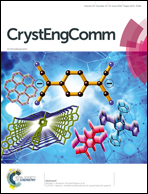Study on the cracking of a KDP seed crystal caused by temperature nonuniformity
Abstract
The phenomenon of the cracking of KDP z-cut seed crystals with a series of sizes due to the temperature difference of the growth solution was explored in detail. Thermal stress generated in the KDP seed crystal at the moment of cracking was calculated using the finite-element method. Temperature differences leading to cracking for heated samples were nearly twice those of cooled specimens. For the cooled samples, the cracks occurred mainly along the (100), (110) and (001) crystal planes and expanded from the sample periphery to the interior spaces, and the opposite crack propagation direction was displayed in the heated samples, with cracks observed mainly along the (110) plane. More importantly, the temperature differences were observed to decrease with an increase in the sample size. In addition, the calculated results indicated that the field distribution of tensile stress is coincident with the points of crack initiation. The maximum stresses calculated were found to be greater than the fracture strength of 6.67 MPa for the KDP crystal along the [100] direction, and the direction of large stresses was found to be normal to the fracture surface. It is interesting that the maximum stress in fracture crystals decreases with an increase in the crystal size as cracks are generated.



 Please wait while we load your content...
Please wait while we load your content...